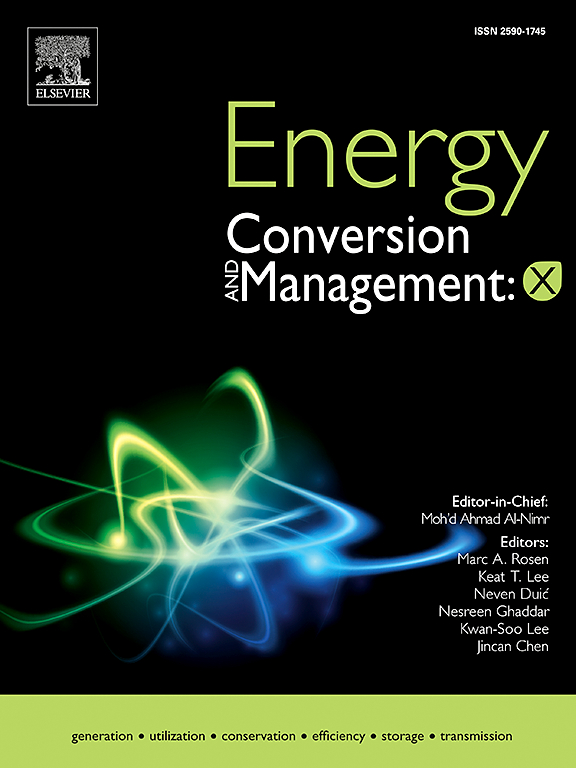乙醇蒸汽重整碳捕集制氢的技术经济分析
IF 10.9
1区 工程技术
Q1 ENERGY & FUELS
引用次数: 0
摘要
可再生制氢是向可持续能源过渡的关键技术,对全球脱碳工作至关重要。本研究探讨了将氢气生产整合到甘蔗生物精炼厂中,这些精炼厂已经从传统的糖生产转变为综合生物能源中心。具体而言,选择乙醇的蒸汽重整工艺作为制氢工艺。制定了一项全面的技术经济分析,以解决研究差距并指导今后的工作。分析了氢生产与碳捕获相结合的方案,说明了减少碳足迹和利用二氧化碳生产化学品的潜力。氢气的最低销售价格确定为基本情景下的4.6美元/公斤,与碳捕集比较情景下的4.9美元/公斤,使其低于当前平均市场价格7.2美元/公斤。每年42,400吨的氢气工厂的资本和运营支出分别为2.731亿美元和1.578亿美元,考虑到每年282,800吨的碳副产品产量,综合碳捕集的计算分别为3.441亿美元和1.678亿美元。这种制氢和碳捕获的双重方法提出了一种实施低碳工艺的策略,未来的生物精炼厂可能会考虑这种策略。这种整合所突出的主要影响是提高甘蔗生物精炼厂的价值主张,利用被低估的能源,如电力和沼气。这项研究强调了将氢气生产大规模纳入甘蔗生物精炼厂的经济和环境效益,为未来的研究和技术发展提供了框架。本文章由计算机程序翻译,如有差异,请以英文原文为准。
Techno-economic analysis of hydrogen production in the sugarcane industry by steam reforming of ethanol with carbon capture
Renewable hydrogen production is a pivotal technology in transitioning to sustainable energy and is essential for global decarbonisation efforts. This study explores the integration of hydrogen production into sugarcane biorefineries, which have shifted from traditional sugar production to integrated bioenergy hubs. Specifically, steam reforming of ethanol was selected as the process for hydrogen generation. A comprehensive techno-economic analysis was developed to address research gaps and guide future work. A scenario of hydrogen production coupled with carbon capture was analysed, illustrating the potential to reduce the carbon footprint and utilise carbon dioxide for producing chemicals. The minimum selling price for hydrogen was determined to be 4.6 US$/kg for the base case scenario and 4.9 US$/kg for the comparison scenario with carbon capture, positioning it below the current average market price of 7.2 US$/kg. The capital and operating expenditures were determined to be US$ 273.1 million and 157.8 million for a 42,400 t/y hydrogen plant, and integrating carbon capture considering 282,800 t/y of carbon co-product yield was calculated at US$ 344.1 million and US$ 167.8 million, respectively. This dual approach of hydrogen production and carbon capture presents a strategy for implementing low-carbon processes that future biorefineries may consider. The primary impact highlighted by this integration is the enhancement of the sugarcane biorefineries’ value proposition, leveraging undervalued energy sources such as electricity and biogas. This study underscores the economic and environmental benefits of incorporating hydrogen production into sugarcane biorefineries on a large scale, offering a framework for future research and technological development.
求助全文
通过发布文献求助,成功后即可免费获取论文全文。
去求助
来源期刊

Energy Conversion and Management
工程技术-力学
CiteScore
19.00
自引率
11.50%
发文量
1304
审稿时长
17 days
期刊介绍:
The journal Energy Conversion and Management provides a forum for publishing original contributions and comprehensive technical review articles of interdisciplinary and original research on all important energy topics.
The topics considered include energy generation, utilization, conversion, storage, transmission, conservation, management and sustainability. These topics typically involve various types of energy such as mechanical, thermal, nuclear, chemical, electromagnetic, magnetic and electric. These energy types cover all known energy resources, including renewable resources (e.g., solar, bio, hydro, wind, geothermal and ocean energy), fossil fuels and nuclear resources.
 求助内容:
求助内容: 应助结果提醒方式:
应助结果提醒方式:


